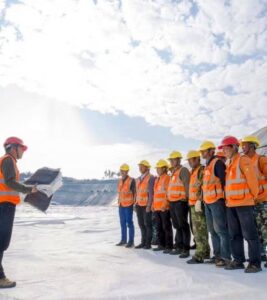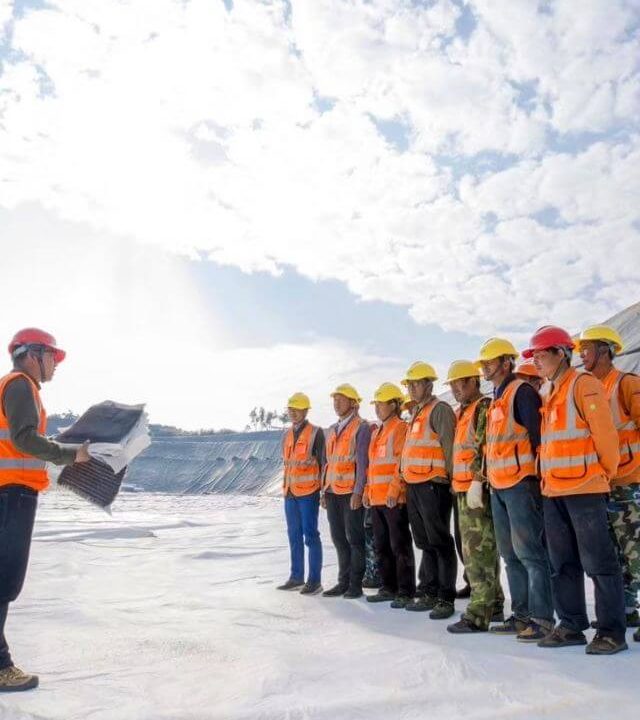What issues should be paid attention to when transporting geotextiles?
There are some key issues to be aware of when transporting geotextiles to ensure they are not damaged or contaminated during transport. Here are some issues you should pay attention to:
Packaging and Protection: Geotextiles are typically supplied in larger rolls or rolls. Make sure these rolls are properly packed and protected to prevent damage from natural elements such as sun, rain, dust, etc. The outer packaging should be secure to prevent the roll from rolling or being damaged during transportation.
Transport vehicles: Choose appropriate transport vehicles, making sure they have sufficient load capacity and have devices to secure the drums to prevent them from moving or rolling during transport.
Loading and Unloading: Use caution when loading and unloading geotextile to ensure that the roll is not damaged by impact or friction. Use appropriate lifting equipment or a forklift to handle the roll to ensure safety.
Avoid sharp objects: During transportation, avoid contact with sharp or sharp objects that may puncture the geotextile. Make sure the rolls are isolated from other goods or objects and that they are not stacked on sharp objects.
Weather Conditions: Transporting geotextiles during adverse weather conditions may result in damage or contamination. During rainy days or extreme temperatures, special care must be taken to protect the geotextile from moisture or heat.
Stacking and Storage: If geotextiles need to be stored in between shipments, make sure they are stored in a dry, well-ventilated area away from direct sunlight and high temperatures. Avoid piling heavy objects on the geotextile to prevent crushing and damage.
Inspect cargo: Before unloading geotextiles, inspect cargo for damage or contamination. If any problems are discovered, contact the supplier or shipping company promptly to resolve the issue and record the loss.
In summary, care and caution are key when transporting geotextiles. Make sure you take appropriate steps to protect geotextiles to ensure they maintain their quality and performance during transportation and storage. If you have any concerns, it is best to consult with a professional geotechnical material supplier or expert for guidance and advice.

What should you pay attention to when installing geotextiles?
Geotextile installation is an important step for land engineering, protection and drainage purposes. The following are key issues to note when installing geotextiles:
Preparation: Before you begin installing geotextile, make sure the work area is clean and free of sharp objects or debris. Remove plants, tree roots, and other obstructions to ensure that the geotextile can be laid flat.
Land Grading: Make sure the land surface is level and has the required slope and slope direction to ensure water can drain properly. Fill, smooth or scrape as necessary.
Correct laying direction: Geotextiles usually have two different surfaces, one rough and one smooth. Generally, the rough side should face the soil and the smooth side should face upward. This helps provide better protection and drainage.
Overlap and Fastening: When laying geotextile, make sure there is sufficient overlap between adjacent rolls or segments, usually 12 inches (approximately 30 cm) or more, to ensure water cannot penetrate. Secure the geotextile to the ground using a sufficient number and strength of fasteners (such as ground nails or U-nails) to prevent it from moving by wind, currents, or other forces.
Avoid damage: When laying geotextile, handle it carefully to avoid scratching, tearing or penetrating the geotextile. Be careful when using tools not to apply excessive pressure or force to the geotextile.
Overlapping seams: When two pieces of geotextile need to be joined, make sure they overlap and make the correct seam. Typically, seams are reinforced using appropriate joint material or glue to prevent water penetration.
Construction Records: During the installation process, create construction records including geotextile type, specifications, overlap distance, fixing method, and any special conditions or issues. This will help track the quality and integrity of the project.
Inspection and Maintenance: Regularly inspect installed geotextiles to ensure they are not damaged or obscured. If any problems are found, repair or replace them promptly.
Work with a professional: If you are unfamiliar with the geotextile installation process, it is best to work with a professional land engineer or contractor who can provide you with professional advice and services.
In conclusion, proper geotextile installation is one of the key steps in ensuring the success of your land engineering project. Follow the manufacturer’s recommendations and ensure construction complies with local codes and standards.
Author
-

Founded in 2002, Tinhy's team focuses on the manufacturing, marketing, installation, application and research and development of geosynthetic materials.
View all posts




